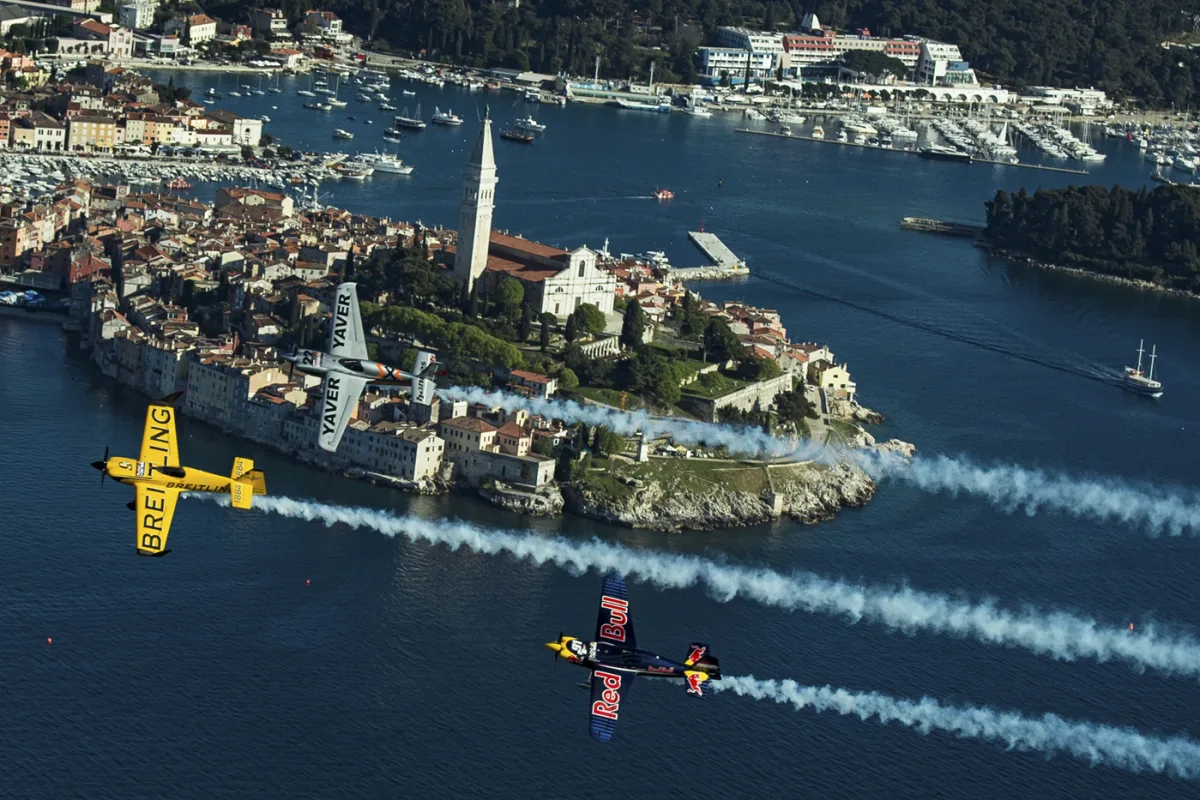Rovinj and the Red Bull Air Race: When Croatia’s Coastal Gem Ruled the Skies
- Teo Drinkovic
- Oct 23
- 5 min read
Discover how the seaside town of Rovinj, Croatia, used a world-class air spectacle to fly onto the global tourism map

Introduction
Perched on the western coast of Istria and gazing out over the Adriatic Sea, Rovinj holds its place firmly as one of Croatia’s most attractive tourist destinations. Here, narrow stone streets, iconic architecture, a rich gastronomic and wine scene, and sweeping nature come together in one city where you don’t need to leave the center to feel you’ve found “more than just the beach”.
Beyond its natural beauty and outstanding food, Rovinj also played host to the world-renowned air race, the Red Bull Air Race of Rovinj, where elite pilots competed in aerial acrobatics during 2014 and 2015.
History of the Settlement
Rovinj’s origins stretch far back: the earliest traces of settlement in the area date to the Bronze Age, and the region was shaped further during Roman times. Under Roman rule, the town bore names like Arupinium or Mons Rubineus. During the 6th and 7th centuries, it became part of the Byzantine Empire and the Exarchate of Ravenna. From 1283 to 1797, Rovinj was under the rule of the Republic of Venice, a period that significantly influenced its architecture and urban character.
Interestingly, until 1763, Rovinj was an island that was only later connected to the mainland by a filled-in channel. Under Austro-Hungarian rule, the town modernized, then after World War I, it fell under Italian administration, and post-World War II became part of the Republic of Croatia. Every layer of governance, people, and cultures is felt as you walk its streets; the stone facades and narrow passages are a blend of Venetian and Mediterranean spirit.
Special Event: Red Bull Air Race in Rovinj
Rovinj turned into a stage for spectacular aerial sports. The Red Bull Air Race World Championship held its stop here: first in 2014, then again in 2015. In 2014, it was the first time the race was held in Croatia. In 2015, it returned to Rovinj, attracting major international attention.
What this meant for Rovinj: the event brought tens of thousands of visitors, strong media coverage, and boosted the town’s brand, not just as a “nice beach spot”, but as a destination capable of hosting major international events. This showed that Rovinj could combine adrenaline and a serious offer, and could position itself on the international tourism map.
This is the picture of airplanes in the Red Bull Air Race in Rovinj, Croatia
Source: Google.com
Attractions & Tourist Destinations
The old town of Rovinj is like a paused postcard: pastel-coloured houses, winding alleys, sea-view vistas, and a church dominating the skyline. The central symbol is the Church of St. Euphemia, Rovinj, from the 18th century, whose bell tower reaches about 60 m and offers a wonderful view over the town and the archipelago before it.
Entering the old core, you’ll also find the Balbi’s Arch (1678/79), a Baroque archway leading towards the famed artist street Grisija. Also worth mentioning are the remains of the town walls, the city gate(s), and many galleries and art studios that add to the charm of the place.
For those who want nature and active rest, there’s an archipelago of about 20 islands and islets in front of Rovinj, and the large park-forest Golden Cape (Punta Corrente) (Zlatni rt), which is ideal for walking, cycling, or just relaxing under pine trees by the sea. A bit of kayaking, a light bike ride, and then chill by the shore, that is a perfect combo.

Historical Sites & Monuments
Besides the Church of St. Euphemia and Balbi’s Arch, you should highlight the medieval chapels and other architectural treasures: the 12th-century Trinitas chapel, Roman remains on the island of St. Andrew’s Island (Crveni otok), and the many tall, narrow stone houses that were built when space inside the city walls was very limited, yielding high and narrow residential blocks.
The city’s maritime tradition is visible through the old harbor, marina, and fishing tradition that testify to Rovinj’s long bond with the sea. The town’s maritime fleet had a “golden” period in the 17th-18th centuries. Museums also offer valuable insight. The Rovinj Heritage Museum (established 1954) displays archaeological finds, artworks, and ethnology. There is also a research center for the region’s multi-cultural history.
Gastronomy & Wine
When we talk about the tastes of Rovinj, they shine. The local cuisine builds on fresh seafood, prawns, oysters, fish, but also on the richness of inland Istria, like truffles, olive oil, local prosciutto, and indigenous wines. The white Istrian grape Malvazija Istarska and the red variety Teran are among the region’s highlight wines.
Near the town, there are wineries offering tastings where you can have an afternoon glass of Malvazija as the sun sets behind Rovinj’s rooftops. Restaurants range from rustic konobas in the old town, with authentic Mediterranean charm, to fine-dining experiences that push the boundaries of expectations. For example, some sources point to a top-level gastronomy in the area, like the restaurant Agli Amici in Rovinj, which enjoys a very high standing.
Famous Beaches in Rovinj
If you thought beaches were just pebbles and stone slabs, yes, that’s true for some, but get ready for more. Rovinj might not offer vast sandy plains and dunes like some tropical destinations, but its bays, rocky and pebbly stretches deliver plenty, because the sea is crystal clear and nature is just next to you.
Among the most notable are Lone Beach in the Zlatni rt area, Monte Beach below the old town, and Kuvi Beach, which is a mix of sand and pebbles. The Golden Cape park-forest provides extra bonus with natural shade, trails for walking, pines, and a calm atmosphere.
The islands in front of Rovinj are in the picture
Source: Google.com
Night Life in Rovinj
Rovinj isn’t exactly Las Vegas, and that’s lucky if you prefer a calmer rhythm. But that doesn’t mean it’s boring. When the sun starts to set, the old-town streets and Riviera feel the local Mediterranean atmosphere.
On terraces, you sip cocktails, drink wine in bars by the sea, hear music drifting from the patios, and feel the relaxed vibe of an evening meet-up. If you’re dreaming of a glam party until dawn, you may need to go to bigger cities nearby, but for a quiet evening with good wine, an accessible and beautiful setting, Rovinj is a hit.
Hotels & Restaurants
When looking for accommodation, you can choose between boutique hotels in the old town core, luxury resorts by the sea, and private lodging with a warm, homey atmosphere and smiling hosts.
For instance, Grand Park Hotel Rovinj is often cited among the top accommodation options with views over the old town and sea. Regarding restaurants, Rovinj offers everything, from cozy family-owned konobas to established fine-dining spots that deliver a top gastronomic experience.
The old town in Rovinj, Croatia

Why Rovinj?
Rovinj is where history meets the present, Mediterranean ease blends with urban comfort, and natural beauty intersects with cultural heritage. When you wander its narrow streets, climb the bell tower of the Church of St. Euphemia, rest on one of the pebbly beaches, or sip excellent Malvazija as the sun sets, you’ll know you’re not just on “another coast”, but in a place that has a story.
Combine that with restaurants, hotels, beaches, tradition, and an event like the Red Bull Air Race, and you’ve got a genuine destination with a strong offer and wonderful people.
















Feel free to comment!